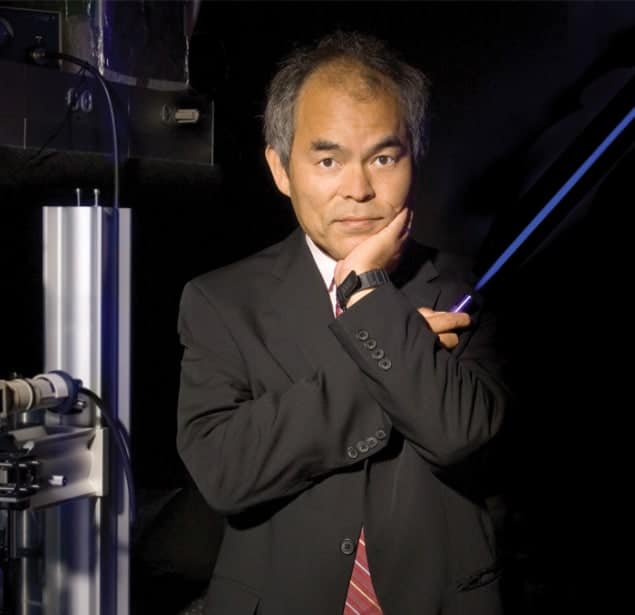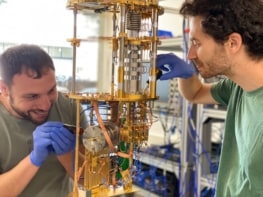After sharing the 2014 Nobel Prize for Physics for the discovery of efficient blue light-emitting diodes (LEDs), Shuji Nakamura talks to Michael Banks about what comes next

How did you start working with blue LEDs?
In the 1980s many people were working on creating blue LEDs using zinc selenide. I was then working at Nichia Corporation and also working towards a PhD. At the time, it was possible to obtain a PhD by just publishing papers, which is called a “paper degree”. So I was mostly interested in publishing as many papers as possible to get my PhD. I began to work on gallium nitride as not many people were working on that material.
Was it exciting when you found you could make an efficient blue LED?
A blue LED is made from various layers of gallium nitride, but you also need indium gallium nitride, which is the key material as it emits blue and green light. Yet when we make LEDs with indium gallium nitride there is a huge dislocation density – a measure of deformation in the material – of around 109 cm–2. Given this huge number, many expected that the material would never work as LEDs because you generally needed a dislocation density less than 103 cm–2 to produce an efficient LED. But we managed to get it to work. Given the high dislocation density, nobody knows the physics behind why it works and is so efficient – it’s still a mystery.
And the Nobel Foundation finally recognized the breakthrough last year?
Yes, I shared the 2014 prize with Isamu Akasaki and Hiroshi Amano. Although it’s funny that indium gallium nitride – the key to blue LEDs – wasn’t mentioned by the Nobel Foundation in the prize announcement. They ignored it. It’s incredible as you can’t make a blue LED without it.
Given the 20-year gap, did it come as surprise to finally win?
No, because ever since the breakthrough in 1993, the Japanese media have followed me in October every year saying that I should be awarded a Nobel prize.
How did you find out you had won?
When the Nobel Foundation called me. It was 2 a.m. local time in California, so I was sleeping.
Has your life changed since?
Not by much. The only difference is that the Japanese media follow me more now and students recognize me. The University of California, Santa Barbara, has also given me a free parking space and I don’t have to teach anymore.
How will you spend the money?
The amount of money you get for winning a Nobel prize is smaller these days. The three of us got $400,000 each. For Nobel week – a series of events marking the award, including the Nobel banquet – I paid the expenses of 14 guests, which came to about $100,000. I was then left with $300,000 and then $150,000 after US taxes. I have also donated half – $75,000 – to the University of Tokushima.
What will they use that money for?
I didn’t tell them how to spend it, so they can use it however they see fit.
How are relations now with Nichia?
I left Nichia in 1999 to move to the University of California, Santa Barbara. As I did not sign a non-disclosure agreement, the firm then filed a lawsuit for infringement of trade secrets. I countersued them using Japanese patent law, which states that an invention belongs to the inventor and not the company. In 2005 I settled with Nichia for a one-off payment of $8m. Since winning the prize I have tried to improve relations with Nichia, but they are not interested. So I won’t be trying again.
Do you feel disappointed by this?
I expected that they would say no, so I am not disappointed. It was actually my former adviser at the University of Tokushima – Osamu Tada – who said that I should aim to improve relations with them.
As your prize is deeply connected with light, will you be involved with the International Year of Light?
I have a lot of invitations to many events around the world, but at the moment I am very busy.
What are you working on now?
Together with my colleagues, we are working on next-generation lighting – laser lighting. Using laser diodes we can obtain a luminescence 1000 times higher than an LED, so we can make a very bright light source. But it will take time to achieve this, maybe 5–10 years.
What are the challenges?
Currently, laser diodes are very expensive – around $10 for a laser diode, but just $0.10 for an LED. Also, the “wall plug” efficiency of laser diodes is around 30%, this is not high enough compared to the blue LED, which is about 50–60%. So we have to find ways to reduce the cost and improve the efficiency further, but we are very excited about the prospect of laser diodes.
- Enjoy the rest of the April 2015 issue of Physics World in our digital magazine or via the Physics World app for any iOS or Android smartphone or tablet. Membership of the Institute of Physics required



